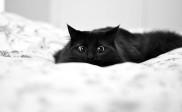How to Capture The Splendor of The Moon
The moon has always attracted photographers, both amateurs and professionals. But if not photographed correctly it just appears as a big white spot on a black background. The moon can be a very tricky subject to photograph but with some patience and practice its beauty can be captured in its purest form.
Two of the most common problems faced while photographing the moon are :
1. The moon looks small in the final image.
2. The picture gets over-exposed.
Following are a few points to keep in mind while photographing the moon and which will help in overcoming these problems. Read on…
Gear
1. Telephoto lens: To photograph moon, it is necessary to use a lens with high zooming capability. A minimum of a 300 mm lens is required to get a good photograph of the moon. Using a telephoto lens is desirable; it can also be supplemented with a tele-converter.
2. Tripod: Because you are using a long lens, there is a high possibility of camera shake and any motion blur can ruin your photograph. Hence, using a sturdy tripod is important to keep the camera still.
3. Shutter-release cable: This isn’t really needed but you can use it to avoid the motion blur caused due to pressing the shutter button.
You can also use the self-timer on your camera to avoid the motion blur.

Photo by Nick. K.
Timing
Before you shoot the moon, it is important that you know when the moon will be in a convenient phase. You can look it up in a calendar or on the internet. There are various websites, like this site, which provide this information. Try to find out about the weather conditions too.

Photo by bradbridgeswater
Aperture
The most common mistake while photographing moon is using a low f-number to allow more light to hit the sensor. What we tend to forget is that the moon is very bright and using a low f-number would completely blow out the image.
Use a smaller aperture (big f-number), preferably somewhere between f-11 and f-16.
Shutter Speed
We generally underestimate the brightness of the moon, and use a long shutter speed to capture the moon. But the moon is brighter than we think it is and you don’t need too much time to capture the light, hence, use a relatively short exposure time.
Do not forget that the moon constantly moves in the sky, using a slow shutter speed will cause motion blur which might spoil your shot.

Photo by StormPenguin-Stock
ISO Settings
Use the lowest ISO value while photographing the moon, in order to capture a clean picture.
Experiment with different combinations of ISO, aperture and shutter speed until you get the desired exposure.

Photo by wyldraven
Shoot in RAW
It is recommended to shoot in RAW as it makes the final image easy to edit in a post-processing software. Also, more detail of the moon can be captured by shooting in RAW.
Composition
Now that your camera settings are ready, the next important thing is composition. There are various ways in which you can compose your image. If it’s a full moon, you can always take the image of the moon by keeping it right in the center, capturing it in its full beauty. What you can also do is frame it by placing the moon between trees, mountains, etc., or have something in the foreground – like a ghostly tree to create a more dramatic effect. Let your imagination run wild, think what looks good with the moon and shoot.
Finally, while photographing the moon, don’t forget to be patient. It may take a while to get the correct exposure and when you get it right you can capture stunning images.




Nice article for capturing bright subjects in dark background. Moon and its phases make good photo-subject.